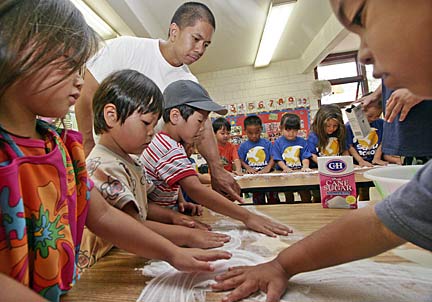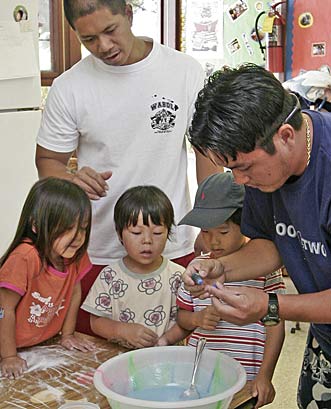
|
Kids exchange cultures
The program at Seagull Schools
is in its eighth year
A cultural exchange at Seagull Schools with preschoolers from Japan can be as simple as making blue mochi.
"It looks like Play-Doh," a youngster volunteers as teacher Scott Yorimoto led a class of 20 in making the mochi Thursday. The students decide it will become ever more delectable with blue food coloring.
He sprinkles the mochi powder and sugar, the main ingredients, on the table so everyone can take part in feeling the difference in textures and mixing them up.
Throughout the procedure, Yorimoto throws out questions, to which they all shout out the answers, except the three boys from Japan, aged 3, who just watch silently.
Ata Edralin, the Kailua school's director, said: "They don't answer till called on. Our kids (from Hawaii) just go for it" and speak up without being singled out.
He's noticed that the children from Japan are shyer and self-disciplined. "They ask a lot more for permission before doing things." They have "very long attention spans" and "pick up (new things) real fast."

Instructor Scott Yorimoto showed Shin Motoyama, right, and Shun Osaki, along with their classmate Alissa Bautista, 5, how to add food coloring to the mochi as Seagull Schools director and teacher Ata Edralin looked on.
In spite of the language barrier, "They don't feel left out. ... They fit right in" with the Hawaii kids, Edralin said.
Two teachers from the Creative Learning Center accompany the Japanese children to share their culture with the Seagull regulars, and to learn more about Hawaiian traditions and practices that they can pass on to their students back home, he said.
Of the four Japanese children who came this year, Shin Motoyama, Shun Osaki and Jisei Hyakutake are 3 years old, and Tao Noda is 2, Edralin said. Some years they've had as many as 10 from Japan.
The class learns numbers, the days of the week and the names of colors in Hawaiian. The curriculum includes a few songs of Hawaii, a visit to a cultural center, eating kalua pig for lunch, and making haupia or coconut pudding, he said.
In turn, the Hawaii children get more acquainted with the Japanese culture, which will be to their advantage in the "melting pot of cultures in the public schools," according to Edralin. They are taught the basics, such as the Japanese words for numbers, colors, days of the week and how to make instant mochi in the microwave.
The Japanese children learn how to assert themselves in disputes by using the phrases "It's mine!" or "I don't like that," Edralin said.
And the local children "become more loving" by helping the Japanese kids when they don't understand something, he added.
E-mail to City Desk
[News] [Business] [Features] [Sports] [Editorial] [Do It Electric!]
[Classified Ads] [Search] [Subscribe] [Info] [Letter to Editor]
[Feedback]
